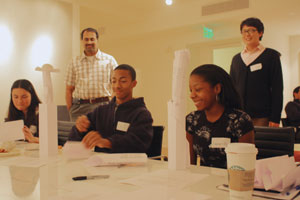The Architecture, Construction and Engineering Mentor Program offers high-school students a chance to discover a range of opportunities in design and construction – and scholarships to help them achieve their goals.

“This program has taken kids with an interest in building and shown them being an engineer is more than being a math geek,” says Denise Richardson, managing director of the General Contractors Association of New York.
More than 50,000 high school students nationally have participated in the ACE Mentor Program since its inception in 1995, with 9,300 taking part in it this year. The organization’s 63 affiliates serve 136 communities. It has 22 national sponsors and has given $6.4 million in scholarships since 1996.
The $230-billion annual construction industry will create more than 1 million jobs by 2012, according to information at the ACE Mentor Program Web site. And John Woodman, director of development for the ACE Mentor Programs of New York and New Jersey, says that even in the poor economy, there is a need to groom up-and-coming professionals.
“It’s a cyclical industry,” Woodman says. “Our hope is the economy will turn around.”
Louis J. Coletti, president and CEO of the Building Trades Employers’ Association in New York, agrees. “There is always a need for a program like this,” he says. “The industry has historically had problems recruiting individuals to come in, and an ongoing program as successful as ACE is critical for bringing young, new talent into the industry.”
Coletti adds that the cyclical nature of the design and construction industries, with their high peaks and deep valleys, keeps some young people away.
“Up until October, when the financial collapse came, there were many other industries where the economic variations were not as deep,” Coletti says. “I think the underpinning of the economy has changed and, hopefully, it will accrue to our benefit.”
Woodman says more education is needed to convince guidance counselors and the general public that construction requires skills that go beyond a willingness to get one’s hands dirty.
“For many years, those of us in the construction and design field have been competing for students against Wall Street and real estate and making deals,” Richardson says. “This program has helped us get kids away from the Wall Street mindset. It’s a fantastic way to channel kids interested in buildings and construction.”
Turner Construction Co., headquartered in New York, is a national sponsor of the ACE program, and company president Peter Davoren is on the organization’s national board of directors. Turner employees serve as mentors, and the company frequently hires young people who have completed the program.
“In order for our industry to continue to grow, we need to be part of the ACE program,” says Hilton Smith, senior vice president of community affairs for Turner. “Without the ACE program, we will not have enough architects, engineers and construction workers to build the infrastructure of our country and the world, even in this economy.”
Cristina Martinez, an associate with the engineering firm Thornton Tomasetti in New York, another national sponsor, says there is a tremendous projected shortage of architects and engineers.
“Other countries are beating us to the punch on training engineers and promoting the professions of construction management,” Martinez says. “The [ACE] program works.”
ACE mentors benefit, too, Martinez says.
“They develop personally and professionally at a much higher rate, and they learn leadership skills and network with other mentors from other firms,” she adds. “It’s a tremendous tool to develop our own staff, outside of designing structures.”
Smith says Turner recognizes that ACE graduates share a commitment to construction, and that may give them an advantage over others when the company brings on a new employee.


Post a comment to this article
Report Abusive Comment